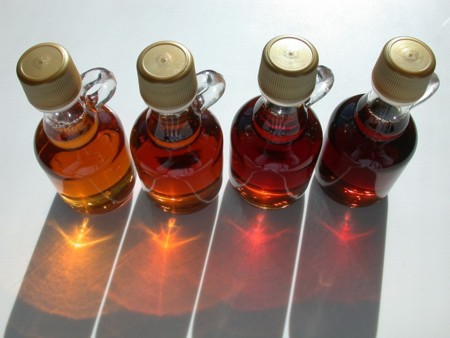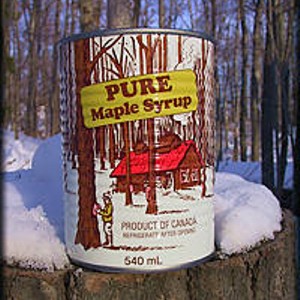We are told that the lion-like March weather we are currently experiencing will result in a later than usual Maple Syrup harvest this year. The good news is, the harvest should be just as bountiful as ever when it gets here. And then your Syrup Savvy comes into play!
 The most popular grades of Maple Syrup: Extra Light, Light, Amber and Dark.
The most popular grades of Maple Syrup: Extra Light, Light, Amber and Dark.
The Basics…
Most of us who live in the North American Maple Syrup Belt (Eastern Canada and the U.S. Northeast) already know the Maple Syrup basics. You drill a hole into a maple tree as soon as the daytime temperatures reach a consistent 5 C (42 F) and the sap runs out into a bucket. Or a pipeline system of food-grade plastic tubing, leading to the Sugar Shack. There a big, flat pan catches the sap and a wood fire underneath boils off the excess water to create the thick, sweet amber liquid we all know and love.
Advanced Maple Syrup…
In Canada, federal regulations divide Maple Syrup comes in three grades: No. 1 (Extra Light, Light and Medium), No. 2. (Amber), and No.3 (Dark). Maple Syrup producing Provinces have their own geading scales, but that’s just going to overcomplicate things in this forum. In the U.S., Maple Syrup is divided into Grade A and Grade B, federally. But, again, producing states – predominantly New Hampshire and Vermont – have their own grading systems, Confused, yet?
From a purely objective point of view, the darker the syrup, the sweeter and more flavourful it is. Light grades come mainly from the early sap ‘runs’ which are composed mainly of water and a little sugar. Darker grades come from later runs which are higher in sugar. Darker grades generally cost more than Lighter ones, but they taste much better!
Did you know?
- It takes from 30 to 50 gallons (120 to 200 litres) of sap to make 1 gallon (4 litres) of syrup.
- Syrup can be boiled down further to create Maple Sugar Candy or granular Maple Sugar.
- Sugar maples must be at least 12 in. (30 cm) in diameter before they can be safely tapped.
- Once tapped, they can produce for 30 years or more.
- Tapping causes no permanent damage to the trees.
- Maple Syrup is often counterfeited, or adulterated, by baddies who seek to make a fast buck. If it doesn’t say 100 % Pure Maple Syrup, it probably isn’t. Move on down the shelf. Settle for nothing less than the real deal.
In conclusion…
Maple Syrup is a sweet deal, especially if you’re lucky enough to live in the Maple Syrup Belt!
Even though it costs more than regular sugar or Cane Syrup, Maple Syrup can add immensely to your enjoyment in baking recipes, sauces and dressings – wherever you would normally use sugar. Play around with Maple Syrup – and keep in mind that it’s many times sweeter than plain sugar. So, maybe it doesn’t cost all that much more in the end!
Want to learn more? Here’s a website that lays it all out for you…
~ Maggie J

